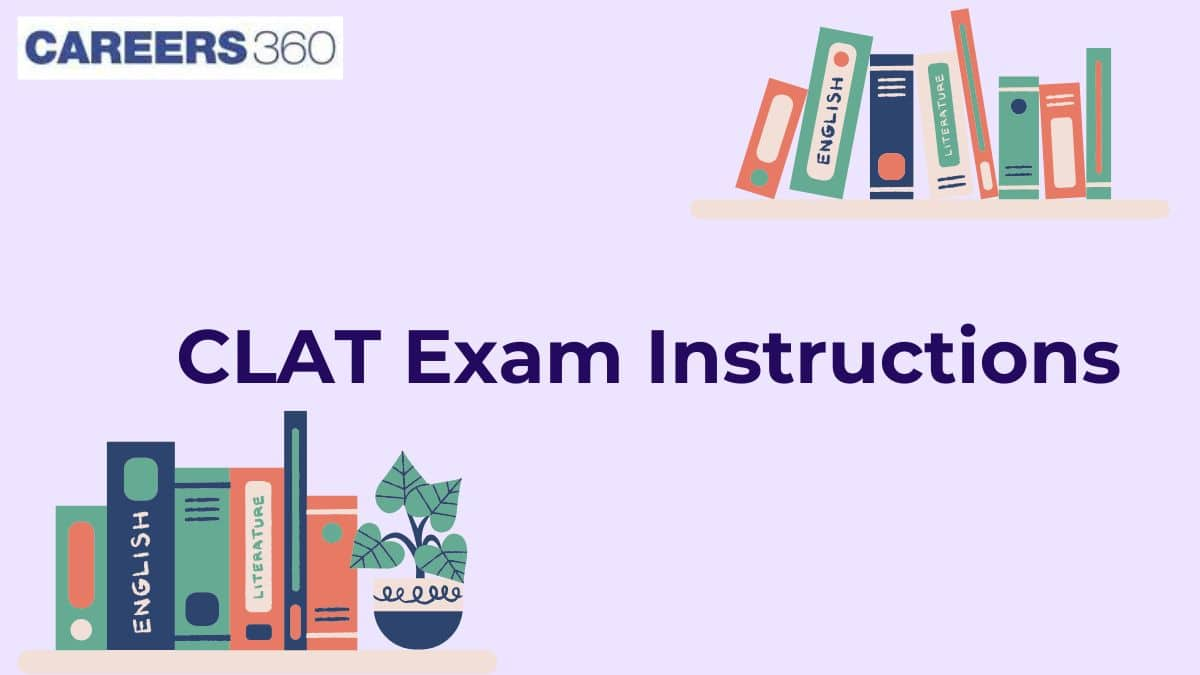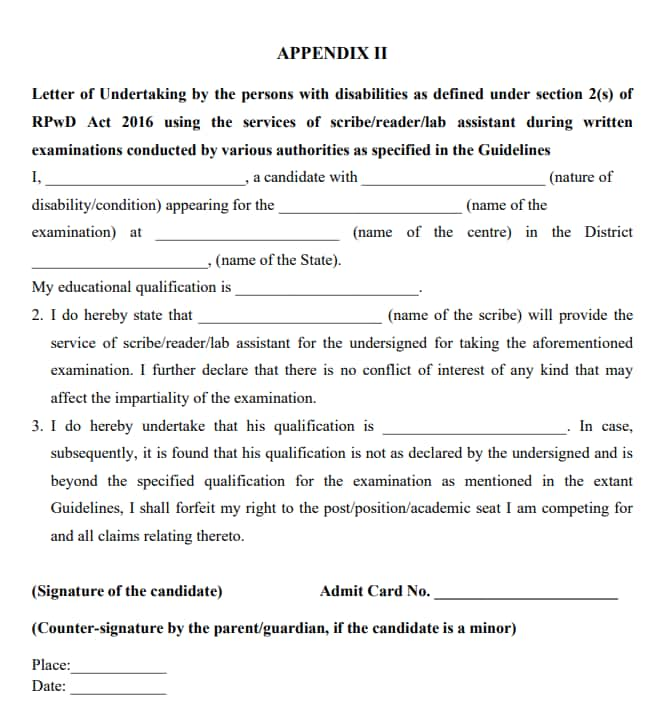Amity University-Noida Law Admissions 2026
Among top 100 Universities Globally in the Times Higher Education (THE) Interdisciplinary Science Rankings 2026
The Consortium of National Law Universities (NLUs) will issue a detailed notification about CLAT 2026 exam day guidelines on its official website: consortiumofnlus.ac.in. The link to the notification will be given below. Earlier, the consortium commenced the CLAT 2026 registration process from August 1 to October 31, 2025. The CLAT 2026 admit card will be issued to registered candidates 15 days before the exam, which also contains all the important CLAT 2026 exam day instructions. The CLAT exam instructions 2026 cover rules, code of conduct, bell timings, list of prohibited items, and several other instructions. Candidates appearing in the CLAT 2026 are advised to read all the CLAT instructions carefully and abide by them to ensure smooth conduct of the examination. Failure to adhere to the CLAT exam instructions may also lead to the disqualification of the candidates from the exam. The Consortium of NLUs will conduct the Common Law Admission Test on December 7, 2025 from 2 pm to 4 pm.
This Story also Contains

The score obtained in the Common Law Admission Test will be accepted by 24 National Law Universities and 60+ affiliated colleges that offer admission to various law programmes such as BA LLB, BBA LLB, B.Com LLB and B.Sc LLB and LLM. Read the complete article to know about the CLAT 2026 exam day guidelines, or if there exists any dress code for CLAT 2026, general instructions and more.
Time | Type of Bell | Purpose |
1:30 P.M | Long Bell | Permitting the entry of Candidates inside the hall/ classroom |
1:50 P.M | Short Bell |
|
2:00 P.M | Long Bell | Commencement of the test. The candidates can open the sealed envelopes |
2:15 P.M | Short Bell | No candidate will be allowed to enter the test centre after this time |
2:30 PM | Short Bell | Marks the completion of 30 minutes of the test |
3:00 P.M | Short Bell | Marks the completion of 60 (sixty) minutes of the test |
3:30 PM | Short Bell | Marks the completion of 1:30 hours of the Test |
3:50 P.M | Short Bell | Warning Bell to indicate that 10 minutes are remaining for the test to end |
4:00 P.M | Long Bell | Marks the Completion of the test. No candidate will be allowed to write anything on the OMR Response Sheet/Question Booklet after this Bell |
The CLAT exam instructions spell out the items that must be carried on the exam day. The following items are allowed inside the exam hall:
CLAT admit card (In case the photograph is not clear on the Admit Card, candidates must bring a self-attested photograph)
ID Proof issued by the government (Voter ID, Passport, Aadhar Card)
Black or Blue Ball Point Pens
A Transparent Water Bottle
An Analogue Watch
Among top 100 Universities Globally in the Times Higher Education (THE) Interdisciplinary Science Rankings 2026
Ranked #18 amongst Institutions in India by NIRF | Ranked #1 in India for Academic Reputation by QS Rankings | 16 LPA Highest CTC
Items to be carried | Prohibited items |
Admit card, photo ID proof, disability proof (If applicable), photograph, blue/black ball pen, transparent water bottle, analog watch | Calculator, digital watch, study material, mobile phone, bags, camera |
Candidates must have valid ID proof with them to appear for CLAT 2026. Given below is a list of valid ID proofs that are acceptable for the exam.
Aadhaar Card
Passport
PAN card
Ration card/PDS photo card
Voter ID card
Driving license
Photo ID issued by a recognised educational institution
Photobank ATM card
Kissan photo passbook
CGHS/ ECHS photo card
Address card having name and photo issued by the department of posts
Certificate of identity having photo issued by gazetted officer or tehsildar on letterhead
Disability ID card/handicapped medical certificate issued by the respective State/UT governments/administrations
Question paper of CLAT
Candidate copy of the OMR sheet
CLAT admit card
In addition to the regular guidelines, the consortium has issued some additional instructions for PWD candidates and specially-abled persons. Candidates who face functional limitations in writing, reading, or comprehending due to physical, visual, intellectual, or other disabilities can avail support as certified by a competent authority. These are given below:
The total time provided to PwDs/SAPs in CLAT 2026 will be 2 hours and 40 minutes.
As per the new guidelines, eligible candidates will be entitled to special accommodations, including compensatory time, scribe/ reader/ lab assistant, use of technological aids, and access to barrier-free examination centre
PwDs/ SAPs should carry their original Disability Certificate to the Test Centre on the day of the CLAT 2026.
To promote independent participation, PwD candidates will be encouraged to use technology-based tools such as screen-reading software, magnification tools, voice recognition software, and recording devices.
PwDs/ SAPs shall make arrangements for their own scribe and bear the associated costs.
Undertaking for candidates using their own scribes is given below:

Candidates should check the guidelines and code of conduct given below before appearing for CLAT exam 2026:
Candidates must carry their CLAT 2026 admit card along with a valid ID proof to the CLAT examination centre.
Candidates should reach at least one hour before the exam to the examination centre.
Candidates will not be allowed inside the examination hall after 15 minutes of the commencement of the examination.
Candidates need to sign their CLAT admit cards in front of their invigilator.
They should not carry restricted belongings such as electronic gadgets and others.
Candidates will be allowed to leave the examination hall only after completion of the exam time.
Candidates who observe any sort of unfair practices must immediately report to the invigilator to protect the integrity of the CLAT examination process.
If anyone is found writing the CLAT exam for someone else or having someone else write the CLAT exam on your behalf will be punishable and result in a serious offense.
Communicating with other candidates, during the examination is considered a violation of CoC.
Candidates appearing for CLAT 2026 should follow the general exam day instructions mentioned in their admit card as well as the instructions issued by the Consortium in their official portal. The general exam day guidelines of CLAT 2026 are given below:
Carry only necessary items and documents in the examination hall. Avoid carrying any prohibited item that can restrict entry in the examination hall.
Candidates should paste their recent passport-size photograph on their CLAT 2026 admit card.
Candidates should carry a valid ID proof in the examination hall along with the admit card.
Candidates are advised to wear half sleeve clothes, without any big buttons that can be used to hide any study material as part of CLAT exam dress code.
Candidates should not be involved in any kind of activity which is completely barred by the Consortium of NLUs.
Candidates need to follow any other special instructions issued at the time of CLAT 2026 examination.
Candidates must carry the CLAT 2026 admit card to the exam hall.
One day before the exam, candidates should be ready with all the necessary documents required to be carried to the CLAT 2026 exam centre.
Candidates should arrive at the CLAT 2026 exam center at least one hour before the exams start.
Candidates should read the CLAT exam day guidelines and follow them throughout the exam.
Candidates should not carry any kind of restricted belongings such as electronic gadgets.
Candidates should not get involved in any kind of activity which is barred by the CNLUs.
The Consortium does not prescribe any specific dress code for CLAT 2026. However, candidates are advised to follow some general guidelines to dress up for the exam. These are given below.
Candidates must wear half-sleeve shorts with no big buttons that can hide concealed material.
Students should wear light-coloured clothes.
Candidates should wear sandals or slippers at the exam centre.
CLAT aspirants are advised to not carry any valuable material with them as there is no safekeeping facility.
Students should also refrain from wearing any chains, lockets, nose pins, rings etc.
Some general instructions that candidates should follow on the exam day have been given below:
Take Sufficient rest: Candidates should take at least 7-8 hours of rest to maintain their composure before the entrance test.
Carry all important documents in a folder: Candidates should carry all the important documents like CLAT 2026 admit card, a government issued photo id proof and double-check the same to avoid any kind of discrepancies at the exam centre in folder.
Get detailed information on the CLAT exam centre: Candidates should have prior information on the assigned CLAT exam centre to avoid trouble at the last moment.
Report on time: Candidates should reach the examination centre at least one hour before the scheduled time.
Also, check -
Frequently Asked Questions (FAQs)
No, a calculator is not allowed in the examination hall.
Candidates should carry one photo Id proof for verification like Aadhar card, driving licence, PAN card etc.
No, candidates don’t need to submit their CLAT 2026 admit card in the examination hall. The admit card will only be checked by the authorities and returned back to the candidate.
CLAT 2026 will be conducted on December 7, 2025.
No, there is no separate reading time allotted to candidates.
Make sure to follow all the exam instructions and be ready with all the documents. Lastly keep a calm mind to perform well in the exam.
Yes, candidates can carry a transparent water bottle with them.
On Question asked by student community
With 67 marks in and SC rank 415 in CLAT, you have a very good chance of getting admission in CNLU Patna BA LLB. The SC category cut-off at Patna NLU are usually much lower than the general category, so your rank is well within the likely range. Final admission
HELLO,
For CLAT 2026 counselling , the only official registration window announced by the Consortium of NLUs was from 17 Dec 2025 to 27 Dec 2025 that was last date to register and pay the fee. There are no additional or alternate registration dates released for 2026 beyond this window.
With an AIR of 34724 and OBC category rank of 7153, chances of getting a seat in DSNLU Visakhapatnam are low in early rounds. However, since you are already invited for counselling, there may be some chance in later rounds depending on seat vacancy and cut-off movement. You should participate
With a CLAT LLM rank of 13656, getting a top NLU is difficult. You may have chances in lower-ranked NLUs or private law universities, depending on seat availability and category.
You can check CLAT LLM counselling details here:
https://law.careers360.com/articles/clat-llm-cut-off
Hello there,
Having a 15000 general rank and 1740 as your SC category rank, your chances of securing a seat are very low. As per the previous trends, it is a direct no for you to get into the top-tier NLUs since the closing general rank is around 1500-3000. If
Among top 100 Universities Globally in the Times Higher Education (THE) Interdisciplinary Science Rankings 2026
Excellent curriculum; an impressive range of electives, besides core law courses. Up to 100% merit scholarship on a first-come, first-served basis
Ranked #18 amongst Institutions in India by NIRF | Ranked #1 in India for Academic Reputation by QS Rankings | 16 LPA Highest CTC
AICTE & UGC Approved | NAAC A+ Accredited
NAAC A++ Approved | Curriculum Aligned with BCI & UGC
India's Largest University | BCI approved | Meritorious Scholarships up to 5 lacs |